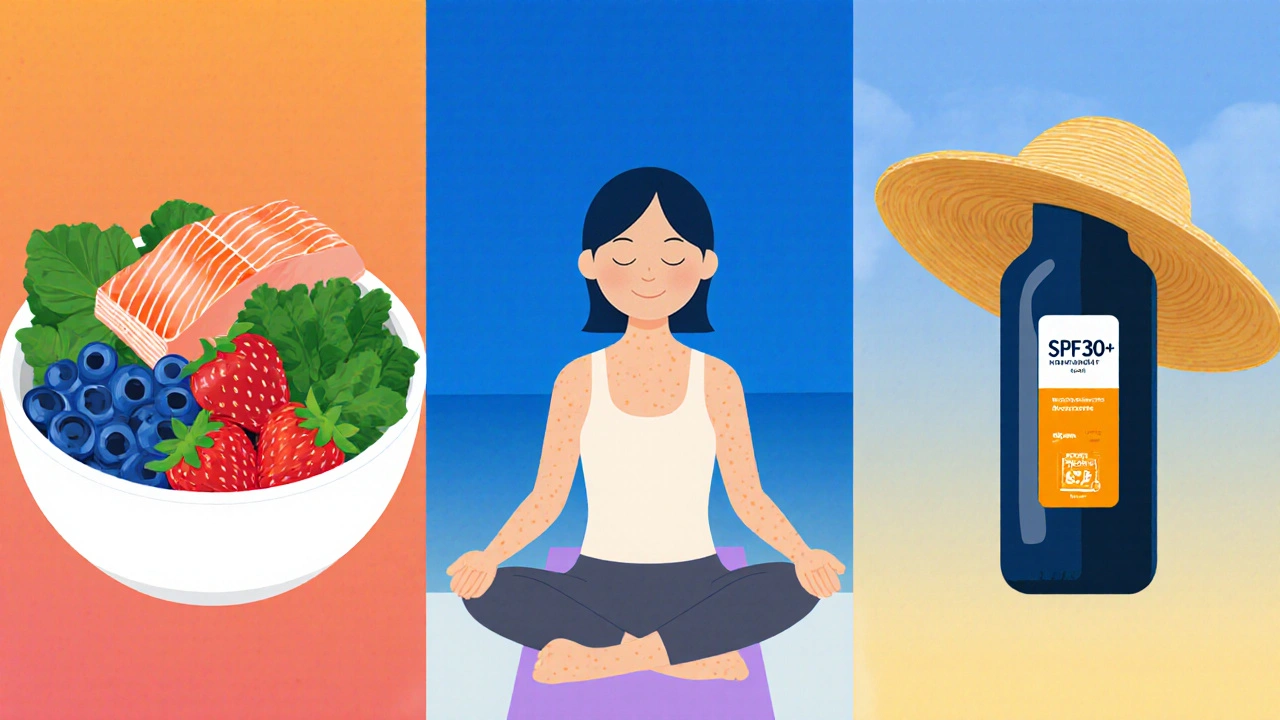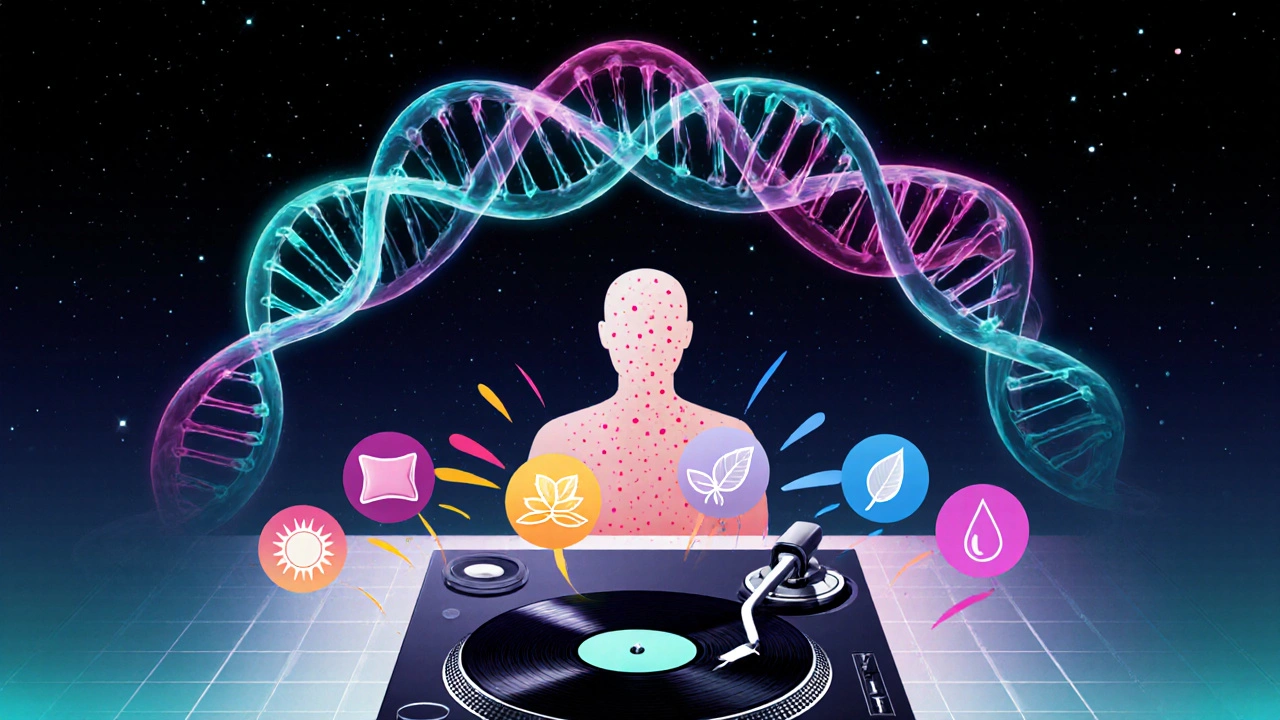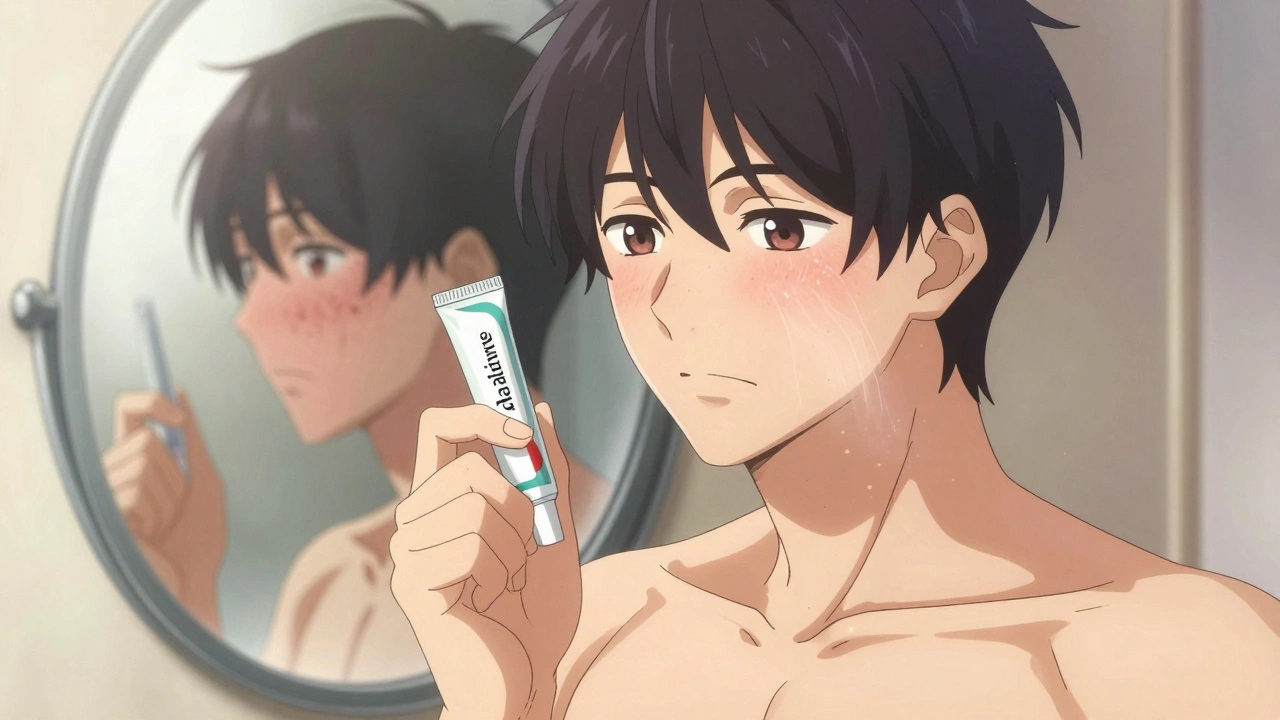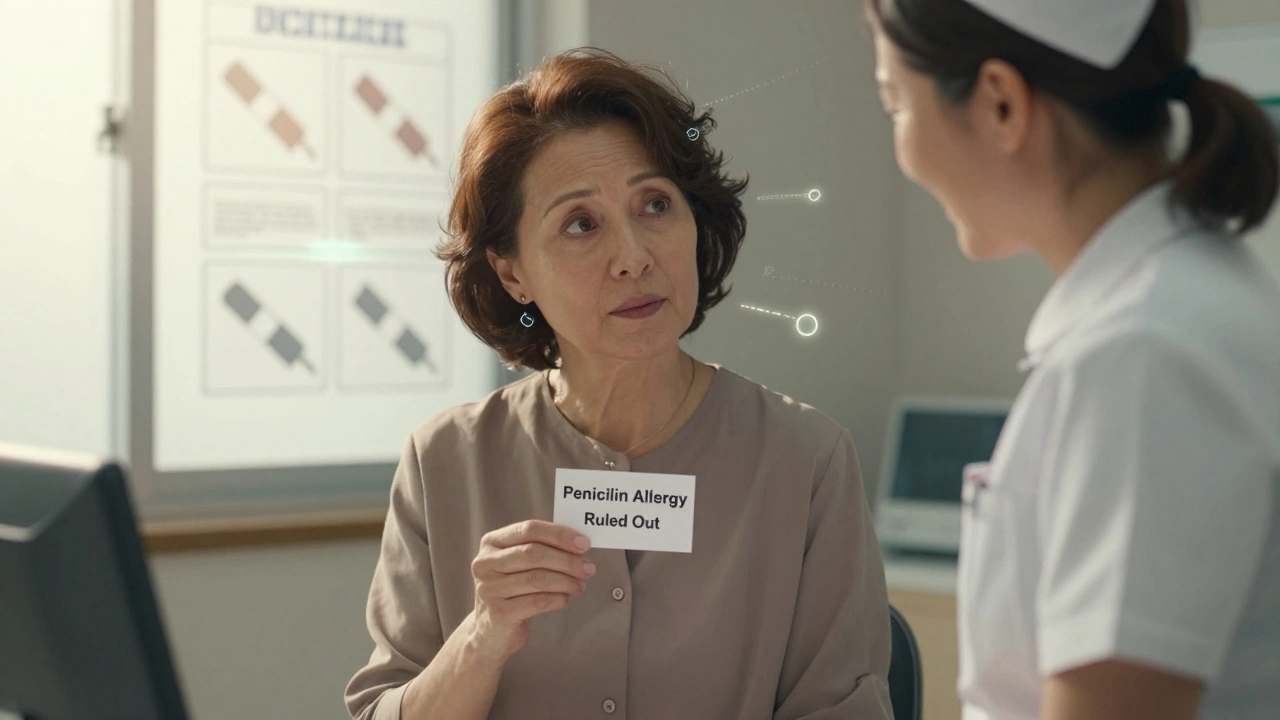Freckle Risk Assessment Tool
Your Freckle Risk Profile
Based on your lifestyle factors, your risk level for freckle development is:
Ever wonder why a few new spots pop up after a hectic week or a change in your daily routine? Those tiny brown specks are often called freckles - clusters of concentrated melanin that appear on sun‑exposed skin. While genetics set the stage, stress and lifestyle choices can nudge the process, sometimes accelerating freckle development in surprising ways.
Key Takeaways
- Stress spikes cortisol, which can boost melanin production and make existing freckles darker.
- Dietary choices rich in antioxidants may counteract oxidative stress that fuels freckle formation.
- Consistent UV exposure remains the biggest driver, but lifestyle habits can amplify or mitigate its impact.
- Managing sleep, stress, and nutrition can slow the appearance of new freckles and keep existing ones subtle.
What Makes a Freckle?
At the core of every freckle is melanin - the pigment your skin makes to protect against UV damage. Specialized cells called melanocytes - cells located in the basal layer of the epidermis that synthesize melanin produce varying amounts of this pigment. When a cluster of melanocytes releases more melanin than surrounding cells, a visible freckle forms.
How Stress Hooks Into Melanin Production
Stress isn’t just a feeling; it triggers a hormonal cascade. The adrenal glands release cortisol - the primary stress hormone that regulates metabolism and immune responses. Research from the Dermatology Research Institute (2023) shows that elevated cortisol can increase the activity of the enzyme tyrosinase, a key player in melanin synthesis. In practical terms, a prolonged stress episode can lead to darker, more pronounced freckles.
Beyond cortisol, chronic stress fuels oxidative stress - a surplus of free radicals that damage skin cells. Oxidative stress can stimulate melanocytes to overproduce melanin as a protective response, adding another layer to the freckle equation.

Lifestyle Factors That Turn Up the Volume
While stress sets the hormonal backdrop, several everyday habits either amplify or calm the freckle‑forming process.
- Sun exposure: UV radiation is the most direct trigger. UV radiation - electromagnetic waves from sunlight that penetrate the skin and stimulate melanin production damages DNA, prompting melanocytes to produce more pigment as a defense.
- Diet quality: Foods high in refined sugars and saturated fats can increase insulin spikes, which in turn raise insulin‑like growth factor (IGF‑1). IGF‑1 is linked to higher melanin activity. Conversely, diets rich in antioxidants - compounds like vitamins C, E, and polyphenols that neutralize free radicals (berries, leafy greens, nuts) help reduce oxidative stress.
- Sleep patterns: Poor sleep disrupts the circadian regulation of cortisol, leading to higher daytime levels that can stimulate melanin.
- Smoking: Tobacco smoke introduces toxins that increase oxidative stress and can alter melanocyte behavior, making freckles more prominent.
- Alcohol consumption: Excess alcohol impairs liver detoxification, leading to higher circulating free radicals and potentially darker freckles.
Nutrition Tips to Keep Freckles in Check
Adopting a skin‑friendly diet doesn’t require a complete overhaul. Here are three simple swaps that add antioxidants and help balance hormone levels:
- Swap sugary snacks for a handful of blueberries or strawberries - both pack over 200mg of vitaminC per cup.
- Replace refined carbs with whole grains like quinoa or oats, which provide steady glucose release and lower IGF‑1 spikes.
- Add a daily serving of fatty fish (salmon, mackerel) for omega‑3 fatty acids, known to dampen inflammatory pathways that can aggravate melanocyte activity.
Managing Stress for Clearer Skin
Because cortisol is a key driver, stress‑management techniques serve as a freckle‑control strategy. Evidence from a 2022 University of York study shows participants who practiced 10‑minute mindfulness breathing exercises twice daily saw a 15% reduction in cortisol levels after four weeks, correlating with noticeably lighter freckles.
Practical ways to lower stress include:
- Brief mindfulness or meditation sessions (5-10minutes) using apps or guided audio.
- Regular moderate exercise - walking, cycling, or yoga - which boosts endorphins and balances hormone levels.
- Maintaining a consistent sleep schedule (7-9hours) to allow cortisol to follow its natural rhythm.

Genetics vs. Lifestyle: Where Does the Balance Lie?
Genetics still accounts for roughly 60% of freckle propensity according to a 2021 twin study. However, the remaining 40% is modifiable. Think of genetics as the base melody and lifestyle as the remix - you can’t change the notes, but you can alter the tempo, volume, and instrumentation.
People with a family history of freckles should be especially vigilant about UV protection and stress reduction, because their skin is already primed to produce melanin.
Practical Guide: Lifestyle Checklist for Freckle Management
| Factor | High‑Risk Behavior | Low‑Risk Alternative | Effect on Freckles |
|---|---|---|---|
| Sun Exposure | Unprotected midday sun | Broad‑spectrum SPF30+ sunscreen, hats | Reduces UV‑induced melanin spikes |
| Stress | Chronic work overload | Daily meditation, regular breaks | Lowers cortisol, slows melanin surge |
| Diet | High‑sugar, low‑nutrient meals | Antioxidant‑rich whole foods | Decreases oxidative stress, steadies IGF‑1 |
| Sleep | Less than 6hours/night | 7‑9hours, consistent bedtime | Regulates cortisol rhythm |
| Smoking/Alcohol | Frequent smoking, binge drinking | Quit smoking, limit alcohol to moderate | Reduces free‑radical load |
When to Seek Professional Advice
If freckles change suddenly in size, color, or texture, it could signal skin conditions beyond melanin, such as lentigines or early melanoma. A dermatologist can perform a dermoscopic exam and, if needed, a biopsy. Even if you’re just aiming for cosmetic lightening, professionals can offer prescription‑strength topical agents (like hydroquinone) or laser therapies that work faster than over‑the‑counter options.
Frequently Asked Questions
Can stress really make my freckles darker?
Yes. Stress raises cortisol, which can increase tyrosinase activity in melanocytes, leading to more melanin and darker freckles. Managing stress often lightens them over time.
Do sunscreen and SPF prevent new freckles?
Broad‑spectrum sunscreen blocks UV‑B and UV‑A rays, the main triggers for melanin production. Consistent use can significantly reduce the formation of new freckles and keep existing ones from darkening.
Are there foods that specifically target freckle formation?
Foods high in antioxidants-berries, citrus, leafy greens, nuts, and oily fish-help neutralize free radicals that otherwise stimulate melanocytes. While no single food erases freckles, a balanced antioxidant‑rich diet supports overall skin health.
Is it possible to completely eliminate freckles without medical treatment?
Natural methods (sun protection, stress control, diet) can fade freckles gradually, but they rarely erase them fully. For a more dramatic reduction, dermatologist‑prescribed creams or laser therapy are the most effective options.
How long does it take to see results after changing lifestyle habits?
Most people notice lighter freckles after 8‑12weeks of consistent sun protection, reduced stress, and an antioxidant‑rich diet. Patience is key because melanin turnover in the skin takes several weeks.






Paul Hill II
October 10, 2025 AT 23:21Interesting take on how stress can actually bump up melanin production. I’ve definitely noticed my freckles getting darker after those crunch periods at work. It makes sense that cortisol might influence skin cells, even if the exact pathway is still fuzzy. Keeping an eye on sleep and stress could be a practical way to manage those sun spots. Thanks for pulling the data together.
Stephanie Colony
October 11, 2025 AT 21:35Honestly, this is just another pseudo‑science article trying to monetize self‑care. The connection between lifestyle and freckles is tenuous at best, and the tool feels like a gimmick. If you want real insight, look at genetics, not how many sugary drinks you gulp. Stop glorifying trivial facts as breakthroughs.
Abigail Lynch
October 12, 2025 AT 19:48Freckles are just sun‑kissed DNA‑reminders.
David McClone
October 13, 2025 AT 18:01Sure, stress turns you into a walking pigment factory. Who needs sunscreen when you have deadlines, right? At least we can blame the boss for those extra spots.
Jessica Romero
October 14, 2025 AT 16:15While the stress‑melanin link is a neat hook, we should also consider the role of oxidative stress from poor diet. Reactive oxygen species can damage melanocytes and alter their activity, leading to uneven pigmentation. Moreover, chronic inflammation, often present in high‑stress lifestyles, can up‑regulate cytokines that affect melanin synthesis. It isn’t just about cortisol spikes; it’s a cascade of hormonal and cellular events. Lifestyle modifications like reduced sugar intake and regular moderate exercise can mitigate some of these pathways, offering a more holistic approach to freckle management. In short, think of your skin as a sensitive system reacting to the whole environment, not just a single stress metric.
Jim McDermott
October 15, 2025 AT 14:28Yo, good points. I think diet matters more than stress.
Sierra Bagstad
October 16, 2025 AT 12:41The interplay between lifestyle factors and cutaneous melanogenesis is a multidimensional problem that cannot be reduced to a single questionnaire. First, consider the endocrine axis: cortisol, adrenaline, and other stress hormones modulate the activity of melanocyte‑stimulating hormone (MSH), thereby influencing melanin production at the cellular level. Second, ultraviolet radiance exposure synergizes with oxidative stress, which is amplified by poor dietary antioxidants; this creates a feedback loop that accelerates pigment deposition. Third, nicotine and other tobacco constituents induce vasoconstriction, reducing oxygen delivery and altering cellular metabolism in the epidermis, which may predispose to irregular pigment accrual. Fourth, habitual sleep deprivation disrupts circadian regulation of DNA repair mechanisms, leading to accumulated mutations in melanocytes and potentially altering their functional dynamics. Fifth, high‑glycemic loads trigger insulin spikes, which have been linked to increased IGF‑1 activity-a growth factor that can stimulate melanocyte proliferation. Sixth, the physical activity component is not merely about calorie burning; regular exercise improves microcirculation and reduces systemic inflammation, both of which are protective against aberrant melanin synthesis. Seventh, the psychosocial stress component must be contextualized within the broader neuro‑immune network, as chronic psychosocial stress can precipitate a pro‑inflammatory state, tilting the balance toward pigment overproduction. Eighth, genetic predisposition remains a cornerstone: polymorphisms in the MC1R gene and other pigmentation loci set the baseline susceptibility, upon which environmental modifiers act. Ninth, skin phototype determines the threshold at which UV‑induced DNA damage translates into visible freckling, reinforcing the importance of personalized sun protection strategies. Tenth, epigenetic modifications induced by lifestyle choices-such as DNA methylation of pigment‑related genes-add another layer of complexity that is only beginning to be understood. Eleventh, the psychosomatic feedback loop is evident when individuals notice increased freckling during periods of heightened anxiety, underscoring a mind‑body connection that is physiologically measurable. Twelfth, nutritional antioxidants like vitamin C, E, and polyphenols can scavenge free radicals generated by UV exposure, mitigating downstream melanogenic signaling. Thirteenth, the role of the gut‑skin axis cannot be ignored; dysbiosis may influence systemic inflammation and thereby affect melanocyte behavior. Fourteenth, chronic exposure to pollutants and particulate matter poses additional oxidative challenges to cutaneous cells, compounding the effects of stress and sun exposure. In sum, while the interactive tool offers a useful heuristic, the underlying biology is far more intricate, demanding a comprehensive, individualized approach to freckle risk assessment and mitigation.
Alan Kogosowski
October 17, 2025 AT 10:55That was an impressive deep‑dive. I’d add that the MC1R variants are especially important for people of Celtic descent. Also, remember that melanin can act as a UV filter, so more isn’t always bad-just a balanced approach.
Ben Lee
October 18, 2025 AT 09:08Totally agree that habits play a role, but we shouldn’t overlook the fact that genetics set a baseline. A good diet, regular sleep, and staying active can only do so much if you’ve got a family history of heavy freckling. Still, the tool is a nice reminder to check those daily habits.
David Brice
October 19, 2025 AT 07:21Spot on! I’d say the most actionable step is to get consistent quality sleep-aim for 7‑8 hours. Pair that with a balanced diet rich in antioxidants, and you’ll likely see a steadier complexion. Also, regular moderate exercise improves circulation, which helps your skin repair itself. Don’t forget sunscreen even on cloudy days; UV can still trigger melanin production. Lastly, try stress‑reduction techniques like meditation or short breaks; they can lower cortisol and indirectly calm your skin.
Zachary Schroer
October 20, 2025 AT 05:35Honestly, most of this is common sense dressed up as science. If you’re already using sunscreen and eating well, you’re probably fine. The rest is just filler for SEO.
Mina Berens
October 21, 2025 AT 03:48Nice tool! 😎 I’ll try it out tomorrow.
Moritz Bender
October 22, 2025 AT 02:01From a dermatological perspective, the tool’s algorithm appears to weight sleep deprivation heavily, which aligns with cortisol‑mediated melanocyte activation. However, the scoring could benefit from incorporating Fitzpatrick skin type as a modifier to improve predictive validity.
Claire Smith
October 23, 2025 AT 00:15The analysis is thorough yet somewhat verbose. It would be helpful to include a concise summary for lay readers.
Lilly Merrill
October 23, 2025 AT 22:28Thanks for the feedback! I’ll keep the summary short and sweet next time.
Charlie Martin
October 24, 2025 AT 20:41Appreciate the suggestion. Concise is often clearer.
Danielle Watson
October 25, 2025 AT 18:55Overall, a solid piece. Minor grammatical tweaks could polish the final read.
Kimberly :)
October 26, 2025 AT 17:08Great job pulling together these lifestyle factors! 👍 I think the interactive element makes it more engaging for users.
Sebastian Miles
October 27, 2025 AT 15:21Thanks! Glad you found it useful.
Harshal Sanghavi
October 28, 2025 AT 13:35Sure, because a questionnaire can replace a dermatologist’s exam. 😂